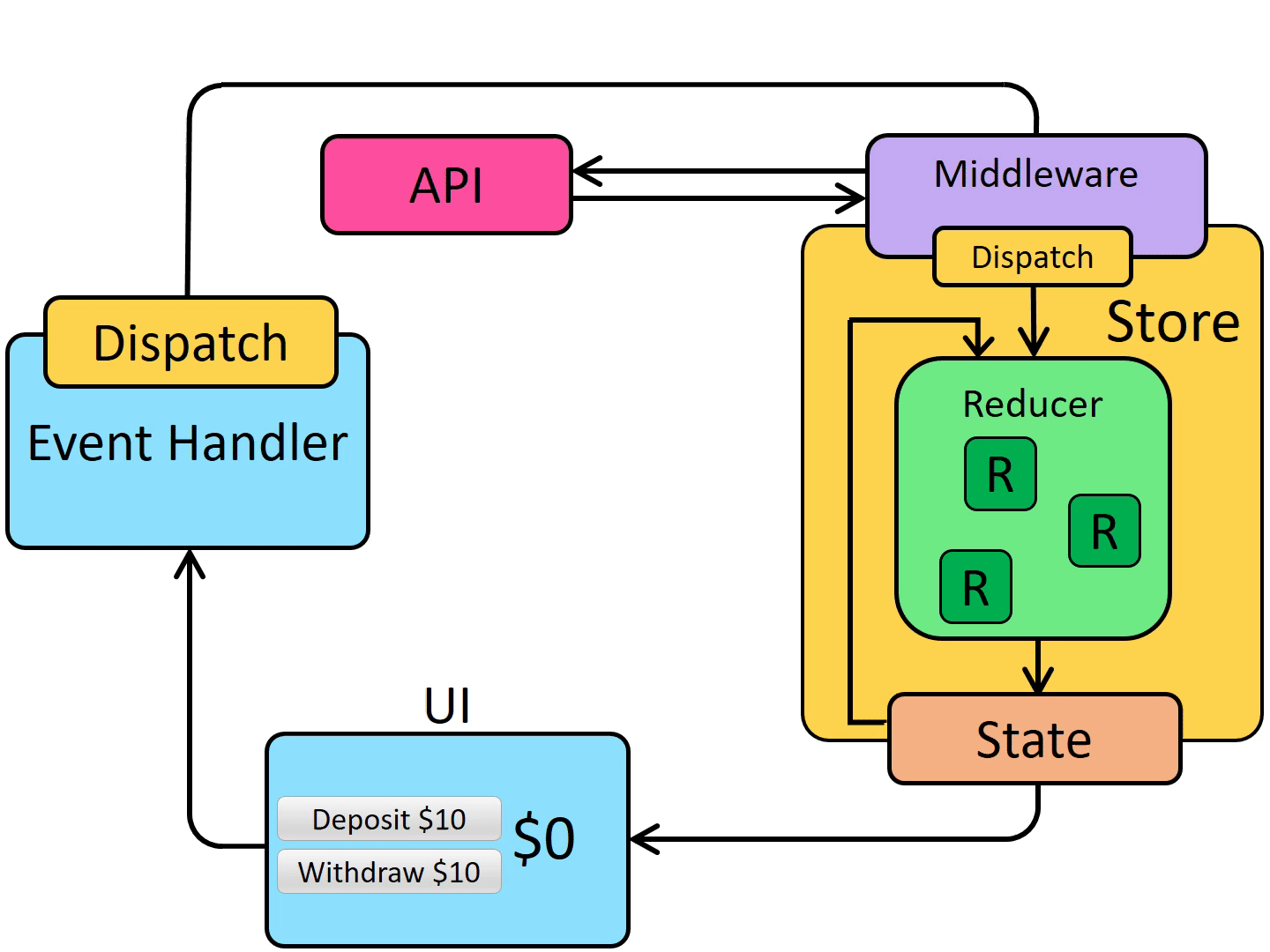Redux异步
在项目中,最基本的功能就是从后端获取数据。在前面的章节中,我们学习使用了Redux,但是在Redux中,action都是同步的,那我们如何在Redux中做异步操作呢?
使用 Middleware 中间件处理异步逻辑
就其本身而言,Redux store 对异步逻辑一无所知。它只知道如何同步 dispatch action,通过调用 root reducer 函数更新状态,并通知 UI 某些事情发生了变化。任何异步都必须发生在 store 之外。
但是,如果您希望通过调度或检查当前 store 状态来使异步逻辑与 store 交互,该怎么办? 这就是 Redux 中间件 的用武之地。它们扩展了 store,并允许您:
- dispatch action 时执行额外的逻辑(例如打印 action 的日志和状态)
- 暂停、修改、延迟、替换或停止 dispatch 的 action
- 编写可以访问
dispatch和getState的额外代码 - 教
dispatch如何接受除普通 action 对象之外的其他值,例如函数和 promise,通过拦截它们并 dispatch 实际 action 对象来代替
使用中间件的最常见原因是允许不同类型的异步逻辑与 store 交互。这允许您编写可以 dispatch action 和检查 store 状态的代码,同时使该逻辑与您的 UI 分开。
Redux 有多种异步中间件,每一种都允许您使用不同的语法编写逻辑。最常见的异步中间件是 redux-thunk,它可以让你编写可能直接包含异步逻辑的普通函数。Redux Toolkit 的 configureStore 功能默认自动设置 thunk 中间件,我们推荐使用 thunk 作为 Redux 开发异步逻辑的标准方式。
早些时候,我们看到了Redux 的同步数据流是什么样子。当我们引入异步逻辑时,我们添加了一个额外的步骤,中间件可以运行像 AJAX 请求这样的逻辑,然后 dispatch action。这使得异步数据流看起来像这样:

Thunk 函数
将 thunk 中间件添加到 Redux store 后,它允许您将 thunk 函数 直接传递给 store.dispatch。调用 thunk 函数时总是将 (dispatch, getState) 作为它的参数,你可以根据需要在 thunk 中使用它们。
Thunks 通常还可以使用 action creator 再次 dispatch 普通的 action,比如 dispatch(increment()):
const store = configureStore({ reducer: counterReducer })
const exampleThunkFunction = (dispatch, getState) => {
const stateBefore = getState()
console.log(`Counter before: ${stateBefore.counter}`)
dispatch(increment())
const stateAfter = getState()
console.log(`Counter after: ${stateAfter.counter}`)
}
store.dispatch(exampleThunkFunction)
为了与 dispatch 普通 action 对象保持一致,我们通常将它们写为 thunk action creators,它返回 thunk 函数。这些 action creator 可以接受可以在 thunk 中使用的参数。
const logAndAdd = amount => {
return (dispatch, getState) => {
const stateBefore = getState()
console.log(`Counter before: ${stateBefore.counter}`)
dispatch(incrementByAmount(amount))
const stateAfter = getState()
console.log(`Counter after: ${stateAfter.counter}`)
}
}
store.dispatch(logAndAdd(5))
Thunk 通常写在“切片”文件中。createSlice 本身对定义 thunk 没有任何特殊支持,因此您应该将它们作为单独的函数编写在同一个切片文件中。这样,他们就可以访问该切片的普通 action creator,并且很容易找到 thunk 的位置。
在我们的todo切片中,添加thunk函数
import { createSlice } from "@reduxjs/toolkit"
const todoSlice = createSlice({
name: 'todo',
initialState: {
todoList: [
{
id: 0,
text: 'some text'
}
]
},
reducers: {
add: (state, action) => {
state.todoList.push(action.payload)
}
}
})
// thunk函数是一个返回一个方法的函数,返回的方法中可以获取到dispatch和getState
// 那么,我们就可以在方法中做异步操作,完成后,再dispatch一个action更新状态
export const fetchData = (params) => {
console.log(params)
return (dispatch, getState) => {
console.log('before fetch', getState())
setTimeout(() => {
dispatch(add({
id: Math.random(),
text: 'load from api'
}))
console.log('after fetch', getState())
}, 3000)
}
}
export const { add } = todoSlice.actions
export default todoSlice.reducer
Thunk的原理
我们在redux-thunk中,找到源码:
import type { Action, AnyAction } from 'redux'
import type { ThunkMiddleware } from './types'
export type {
ThunkAction,
ThunkDispatch,
ThunkActionDispatch,
ThunkMiddleware
} from './types'
/** A function that accepts a potential "extra argument" value to be injected later,
* and returns an instance of the thunk middleware that uses that value
*/
function createThunkMiddleware<
State = any,
BasicAction extends Action = AnyAction,
ExtraThunkArg = undefined
>(extraArgument?: ExtraThunkArg) {
// Standard Redux middleware definition pattern:
// See: https://redux.js.org/tutorials/fundamentals/part-4-store#writing-custom-middleware
const middleware: ThunkMiddleware<State, BasicAction, ExtraThunkArg> =
({ dispatch, getState }) =>
next =>
action => {
// The thunk middleware looks for any functions that were passed to `store.dispatch`.
// If this "action" is really a function, call it and return the result.
if (typeof action === 'function') {
// Inject the store's `dispatch` and `getState` methods, as well as any "extra arg"
return action(dispatch, getState, extraArgument)
}
// Otherwise, pass the action down the middleware chain as usual
return next(action)
}
return middleware
}
const thunk = createThunkMiddleware() as ThunkMiddleware & {
withExtraArgument<
ExtraThunkArg,
State = any,
BasicAction extends Action = AnyAction
>(
extraArgument: ExtraThunkArg
): ThunkMiddleware<State, BasicAction, ExtraThunkArg>
}
// Attach the factory function so users can create a customized version
// with whatever "extra arg" they want to inject into their thunks
thunk.withExtraArgument = createThunkMiddleware
export default thunk
它的源码非常少,主要概念就是:
判断一个action是否是方法,如果是方法,就执行该方法,并且把dispatch, getState作为参数传入该方法,那么在该方法中就可以正常dispatch action和获取state了
如果action不是方法,那就不做任何操作
所以,在使用redux-thunk中间件后,dispatch可以不仅是传入action了,还可以传入thunk函数